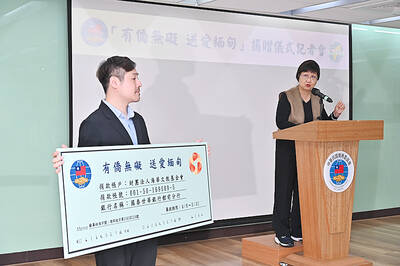Italy’s Narcissus Quagalita, who is seen by many as the world’s greatest glass artist, has entered discussions with the Kaohsiung Rapid Transit Corp (KHRTC) over intellectual property rights and royalties concerning his Dome of Light, which is displayed at the Kaohsiung Mass Rapid Transit (MRT) system’s Formosa Boulevard Station. The talks are focusing on the fact that any use of the artwork for commercial purposes could represent a copyright infringement.
At 30m in diameter and covering an area of about 660 ping (2,180m²), the Dome of Light is in the world’s largest domed underground station.
Quagalita made the piece in cooperation with Derix Glasstudios in Germany. The dome, which is made of 4,500 glass panels, symbolizes rebirth and Taiwan’s democratic process. The four parts that comprise it — water, earth, light and fire — symbolize birth, growth, glory and destruction respectively.

PHOTO: WANG JUNG-HSIANG, TAIPEI TIMES
Located close to where the Kaohsiung Incident occurred, the Formosa Boulevard Station sits at the intersection of the MRT’s red and orange lines.
With the orange line scheduled to begin operations later this month, the KHRTC has developed plans to design and sell souvenirs as well as sell tickets for in-depth tours of Quagalita’s work. Bridal companies have also been lining up to use it as a location for wedding photos.
As the KHRTC only has ownership rights and that any commercial use of the dome involves intellectual property rights, negotiations must be held with the original designer to avoid any copyright infringement.
KHRTC general manager Fan Chen-po (范陳柏) said that such proceedings were international practice and that it was only natural for the KHRTC to follow intellectual property rights and copyright legislation.
The company said its main concern remained ensuring that the work of art does not get damaged or destroyed by visitors.

DEFENSE: The National Security Bureau promised to expand communication and intelligence cooperation with global partners and enhance its strategic analytical skills China has not only increased military exercises and “gray zone” tactics against Taiwan this year, but also continues to recruit military personnel for espionage, the National Security Bureau (NSB) said yesterday in a report to the Legislative Yuan. The bureau submitted the report ahead of NSB Director-General Tsai Ming-yen’s (蔡明彥) appearance before the Foreign and National Defense Committee today. Last year, the Chinese People’s Liberation Army (PLA) conducted “Joint Sword-2024A and B” military exercises targeting Taiwan and carried out 40 combat readiness patrols, the bureau said. In addition, Chinese military aircraft entered Taiwan’s airspace 3,070 times last year, up about

Taiwan is stepping up plans to create self-sufficient supply chains for combat drones and increase foreign orders from the US to counter China’s numerical superiority, a defense official said on Saturday. Commenting on condition of anonymity, the official said the nation’s armed forces are in agreement with US Admiral Samuel Paparo’s assessment that Taiwan’s military must be prepared to turn the nation’s waters into a “hellscape” for the Chinese People’s Liberation Army (PLA). Paparo, the commander of the US Indo-Pacific Command, reiterated the concept during a Congressional hearing in Washington on Wednesday. He first coined the term in a security conference last

A magnitude 4.3 earthquake struck eastern Taiwan's Hualien County at 8:31am today, according to the Central Weather Administration (CWA). The epicenter of the temblor was located in Hualien County, about 70.3 kilometers south southwest of Hualien County Hall, at a depth of 23.2km, according to the administration. There were no immediate reports of damage resulting from the quake. The earthquake's intensity, which gauges the actual effect of a temblor, was highest in Taitung County, where it measured 3 on Taiwan's 7-tier intensity scale. The quake also measured an intensity of 2 in Hualien and Nantou counties, the CWA said.

The Overseas Community Affairs Council (OCAC) yesterday announced a fundraising campaign to support survivors of the magnitude 7.7 earthquake that struck Myanmar on March 28, with two prayer events scheduled in Taipei and Taichung later this week. “While initial rescue operations have concluded [in Myanmar], many survivors are now facing increasingly difficult living conditions,” OCAC Minister Hsu Chia-ching (徐佳青) told a news conference in Taipei. The fundraising campaign, which runs through May 31, is focused on supporting the reconstruction of damaged overseas compatriot schools, assisting students from Myanmar in Taiwan, and providing essential items, such as drinking water, food and medical supplies,